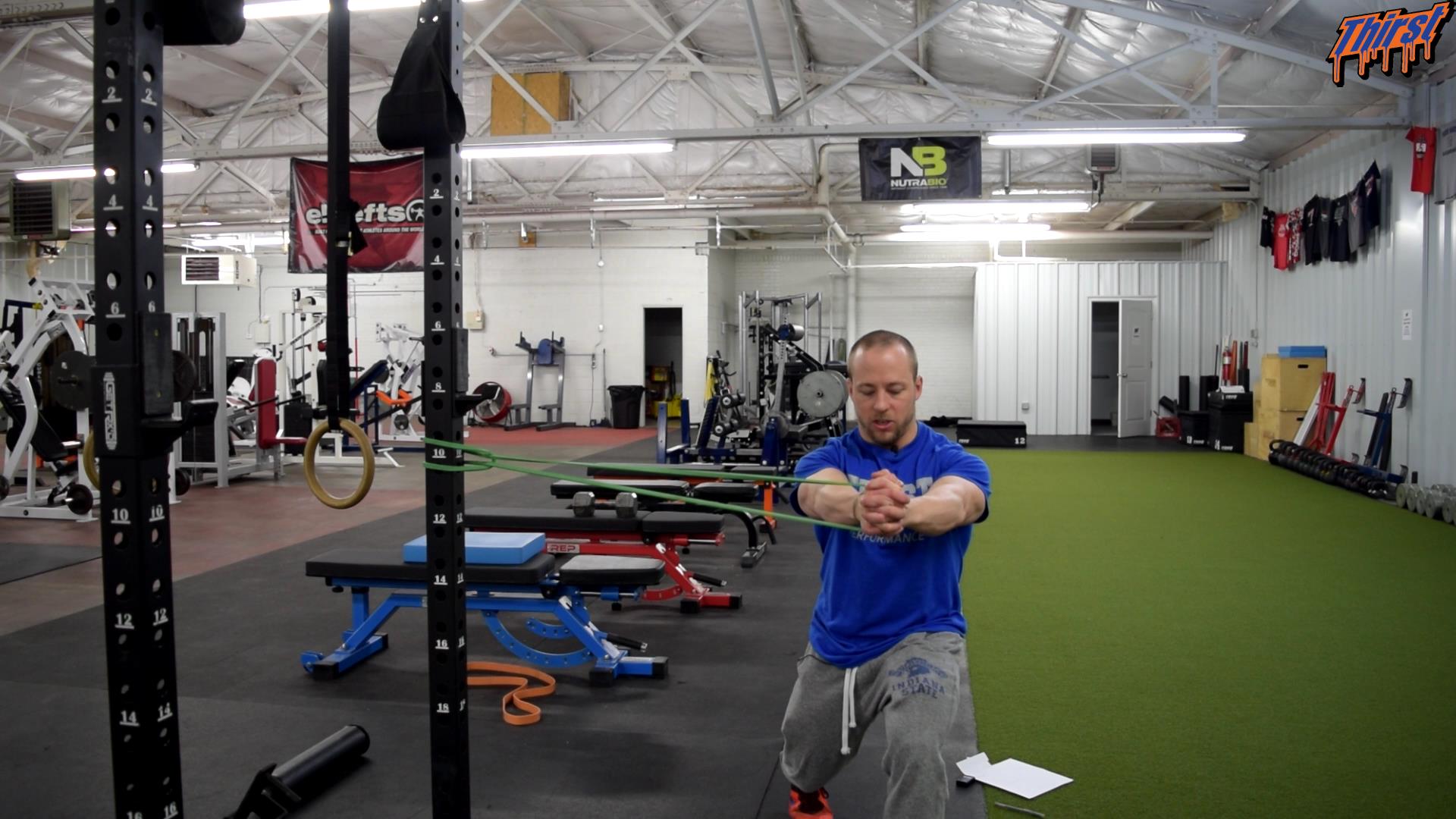Split Stance Band Pallof Press: The Ultimate Core and Hip Flexor Exercise
The split stance band Pallof press represents a significant evolution from the traditional band Pallof press, offering athletes and fitness enthusiasts a more dynamic and functional approach to core strengthening. This exercise combines anti-rotational core training with hip flexor lengthening, making it an invaluable addition to any comprehensive training program.
Watch the video below on how to maximize this exercise.
What Makes the Split Stance Band Pallof Press Special?
Unlike the standard band Pallof press performed in a standing position, the split stance variation places you in a more athletic position that better mimics real-world movement patterns. This exercise primarily targets your abdominal muscles and core trunk while simultaneously providing a beneficial hip flexor lengthening component. The split stance position creates a more challenging stability demand, requiring greater coordination and strength throughout your entire kinetic chain.
The beauty of this exercise lies in its dual-purpose nature. While your core muscles work overtime to resist the rotational force of the band, your hip flexors in the back leg receive a gentle but effective stretch. This combination makes it particularly valuable for athletes who spend considerable time in flexed positions or anyone looking to improve their functional movement patterns.
Essential Equipment and Setup
To perform the split stance band Pallof press effectively, you’ll need minimal equipment: a resistance band and some form of anchor point such as a rack, pole, or sturdy attachment. The key to maximizing this exercise begins with proper hand positioning on the band.
Rather than simply gripping the band with your fingers, create a more secure and comfortable handle by placing the band in your palm and wrapping your hands around it. This technique provides superior grip strength and reduces hand fatigue during longer sets, allowing you to focus entirely on the movement quality rather than struggling to maintain your hold on the band.
Step-by-Step Exercise Execution
The setup process begins by walking out from your anchor point until you feel appropriate tension in the band. Position the band at your midline, approximately at chest height when standing. The critical transition happens when you move into your split stance position.
Take one foot back and one foot forward, creating a stable base of support. Your back leg should be positioned so that you’re up on your toe, while your front foot remains flat on the ground with full contact. The back knee should drop down as you sink into what resembles a quarter to half squat lunge position.
Once you’ve established this split stance, bring the band toward your midline and prepare for the pressing motion. Your ribs should be pulled down, creating a strong, stable core position. From here, execute a controlled press outward, hold briefly, then return the band to the starting position with control.
Mastering the Anti-Rotation Component
The primary challenge of this exercise lies in resisting the rotational force that the band creates. Many beginners make the mistake of allowing the band to pull them sideways or pressing at an angle rather than straight out. The goal is to maintain perfect alignment while feeling as though you’re pushing against an angled force.
Think of it as creating an internal battle: the band wants to rotate your torso, but your core muscles must work together to maintain a straight, controlled press. This anti-rotation component is what makes the exercise so effective for developing functional core strength that translates to athletic performance and daily activities.
Programming and Integration
The split stance band Pallof press works best when programmed for three to four sets of six to twelve repetitions per side. Remember to switch sides to ensure balanced development. The exercise fits particularly well at the end of training sessions, either as part of metabolic conditioning circuits or combined with prehab and rehab exercises.
Consider creating mini-circuits that include two to four exercises with minimal rest between movements. This approach allows you to address accessory work while building an aerobic component into your training. The split stance Pallof press pairs excellently with hamstring stretches, shoulder mobility work, or other corrective exercises.
Customization and Progression
One of the greatest advantages of this exercise is its adaptability. You can easily adjust the band tension to match your current strength level or training goals. Additionally, modifying the height of the band attachment allows you to target slightly different angles and muscle activation patterns.
When setting up, aim to position the band so that when you’re in your split stance position, it aligns approximately with your belly button area. This positioning ensures that the band pulls straight out from your core, creating optimal resistance patterns.
Benefits for Athletic Performance
The split stance band Pallof press offers unique benefits that extend far beyond simple core strengthening. The position mimics many athletic stances and movements, making it highly transferable to sports performance. The combination of core stability, hip flexor mobility, and anti-rotation strength creates a foundation for improved movement quality in virtually any athletic endeavor.
This exercise is particularly valuable for athletes who need to maintain core stability while in dynamic positions, such as runners, soccer players, basketball players, and martial artists. The unilateral nature of the stance also helps address any imbalances between sides while building functional strength patterns.
The split stance band Pallof press represents an excellent progression from basic core exercises, offering a challenging yet accessible way to build the stability and strength needed for both athletic performance and daily life activities.








